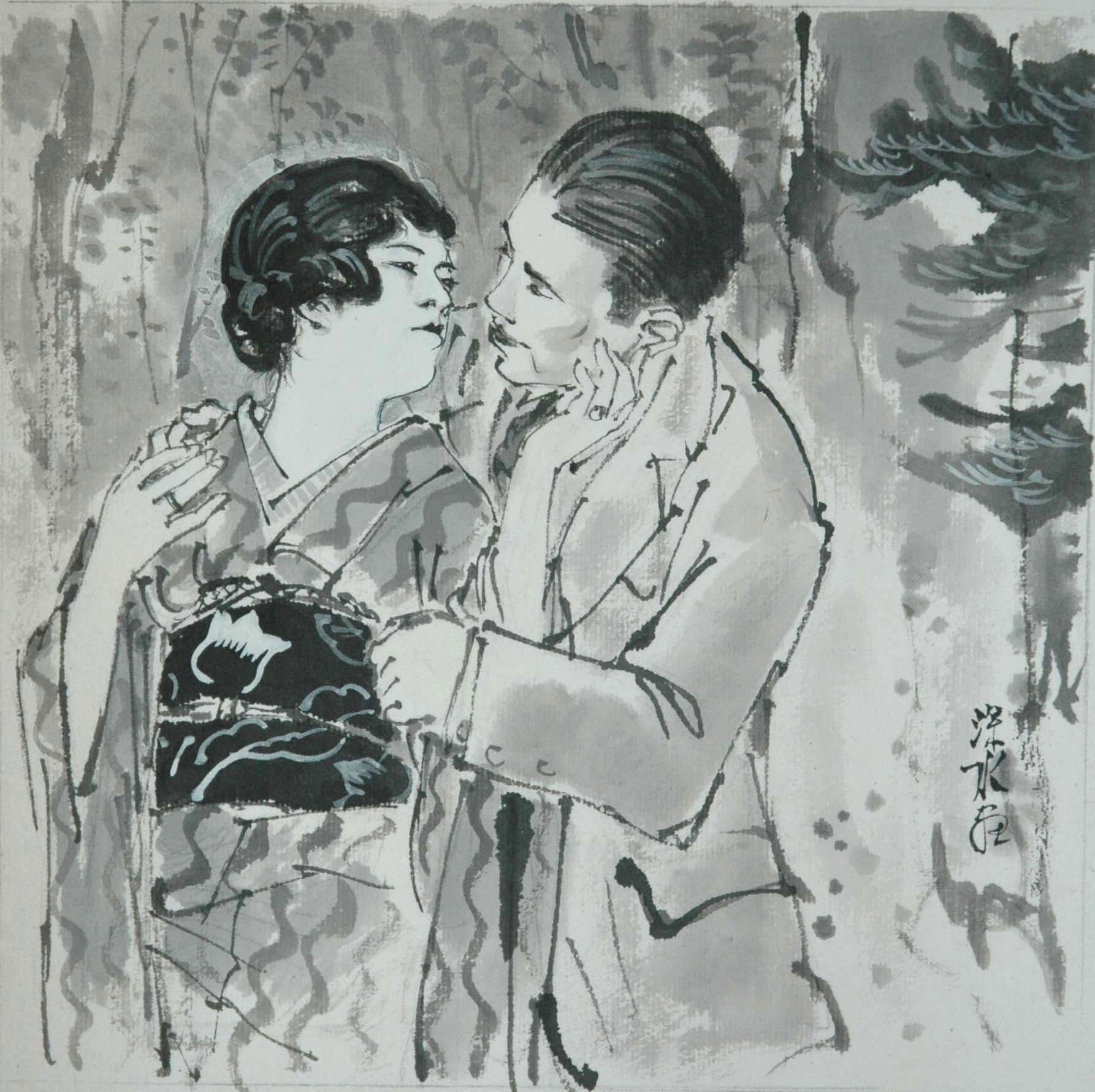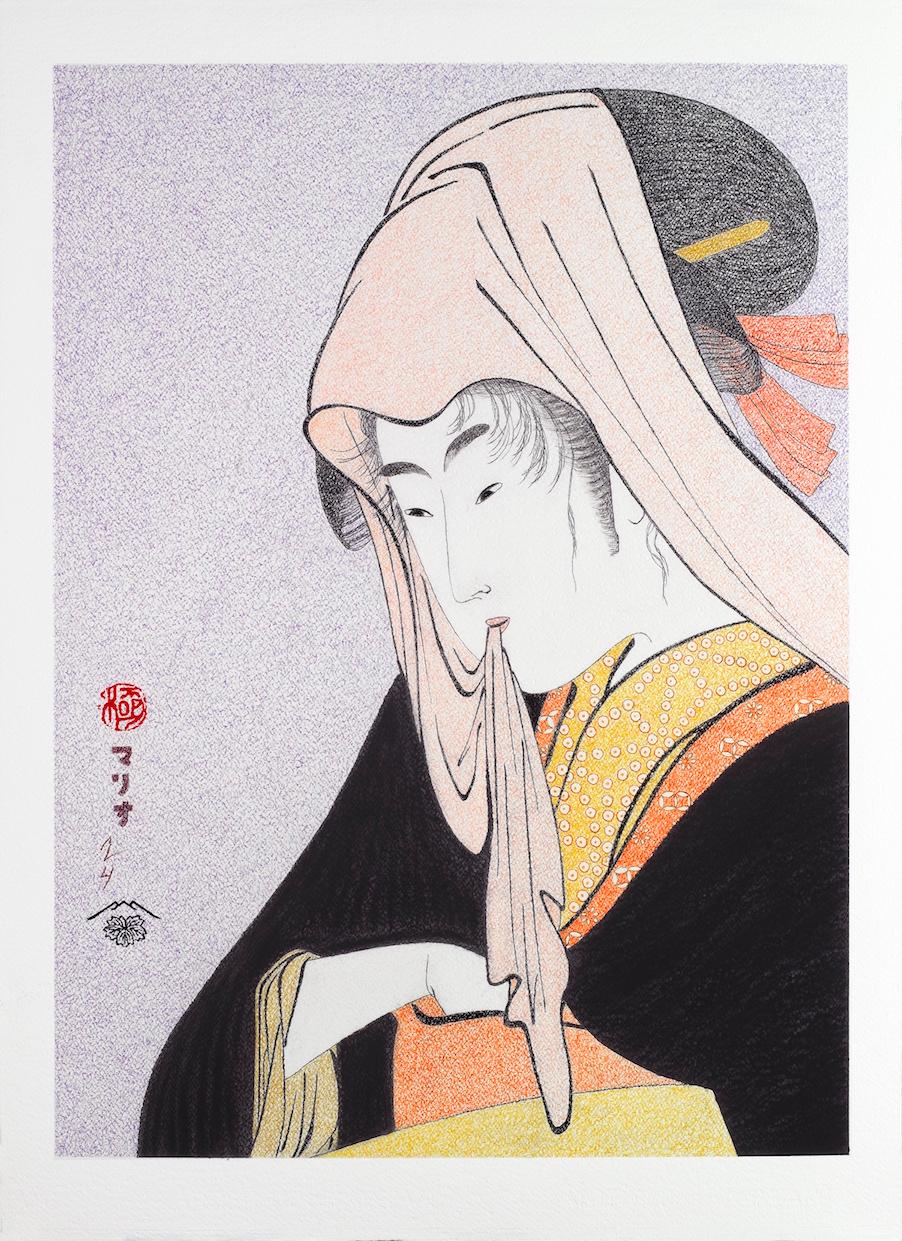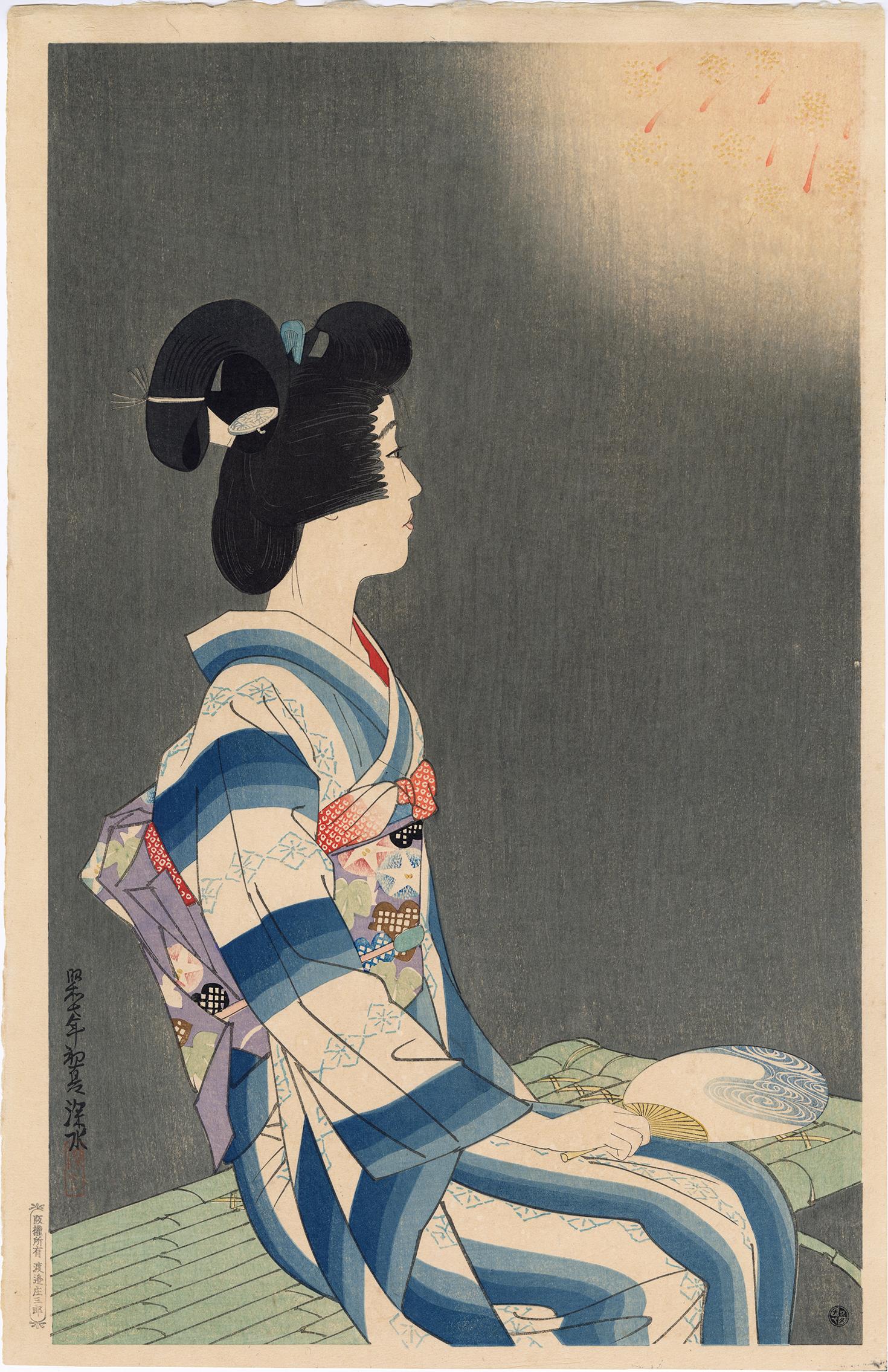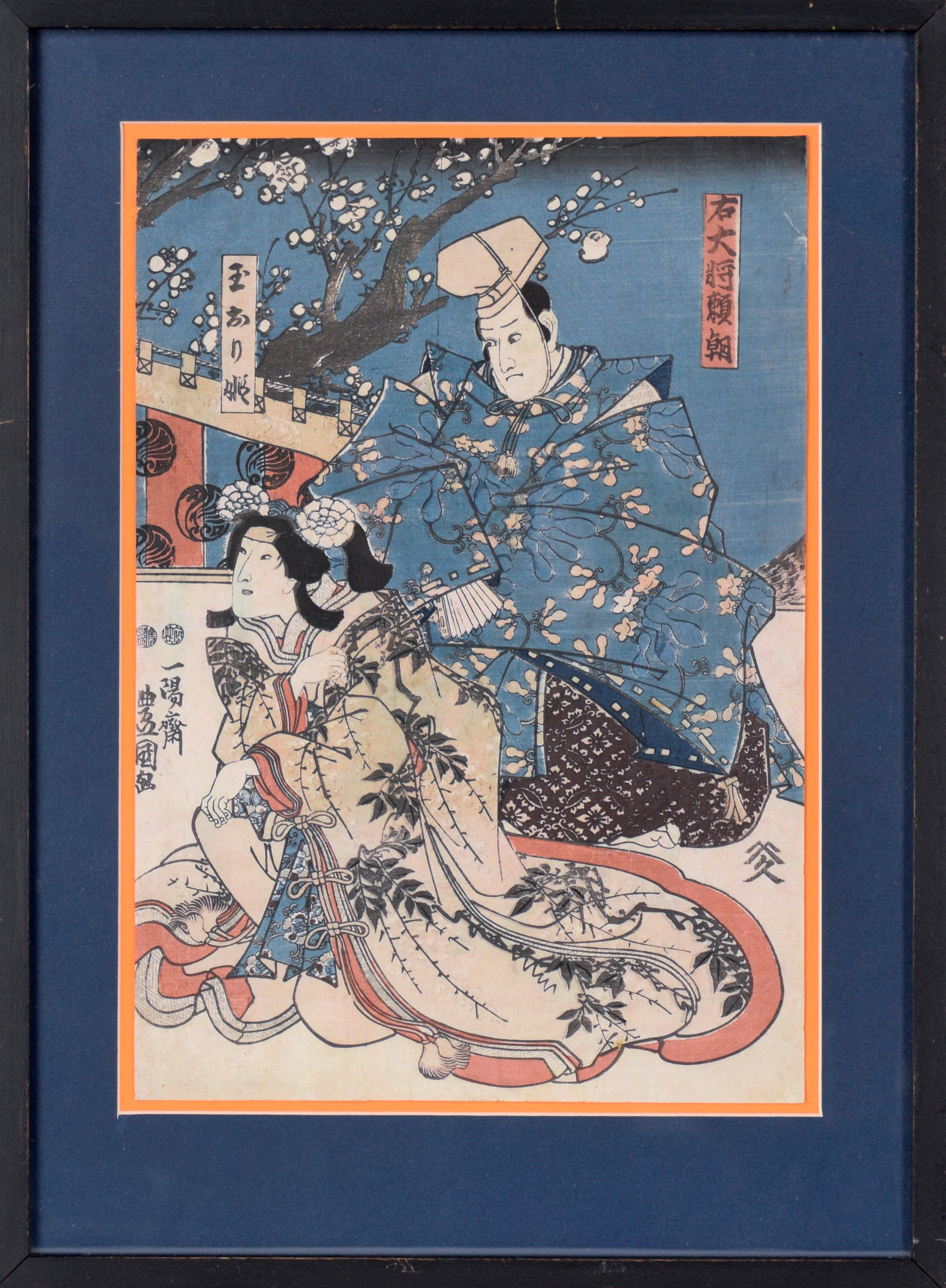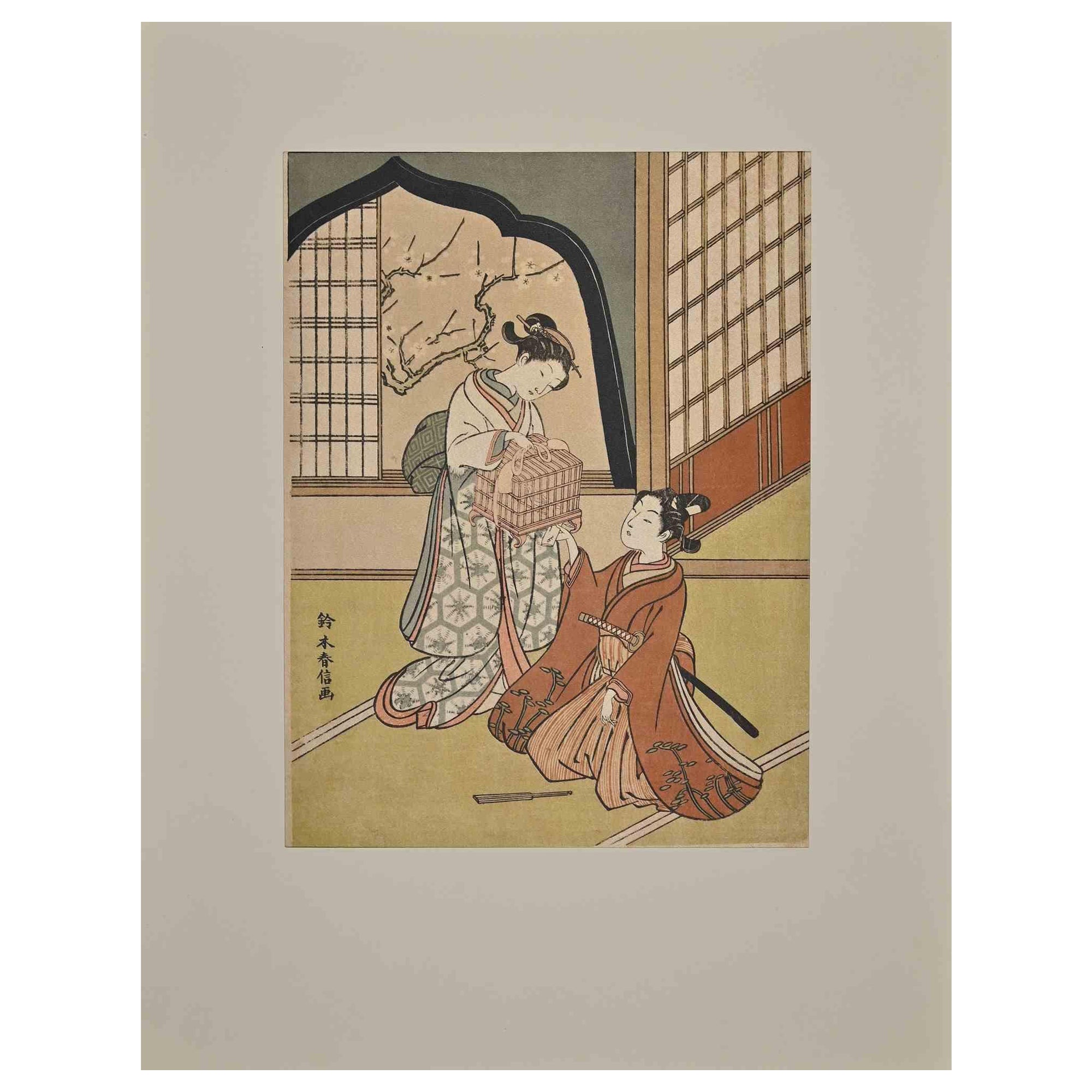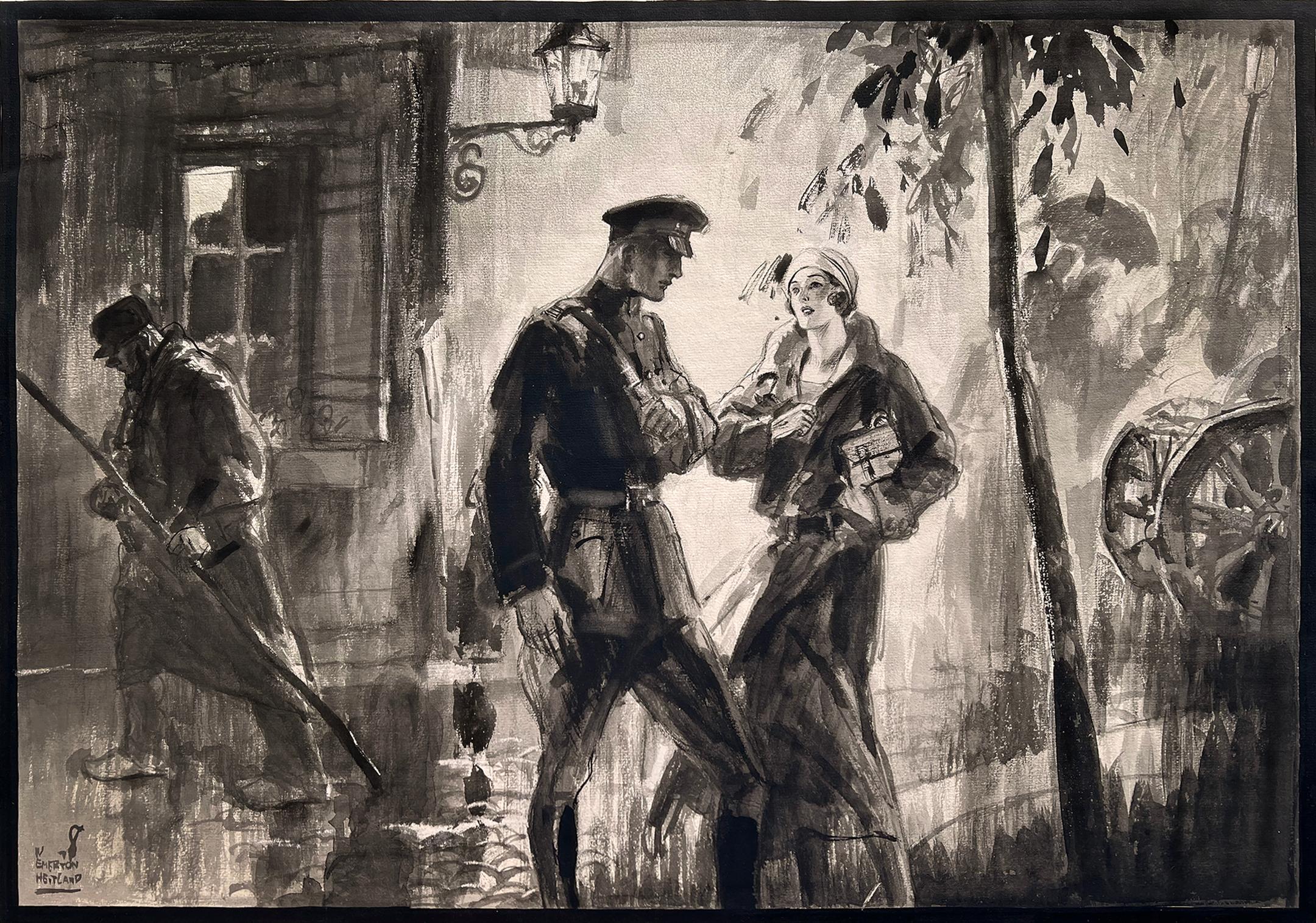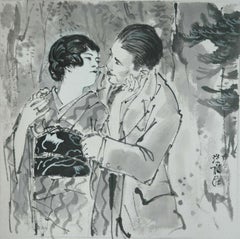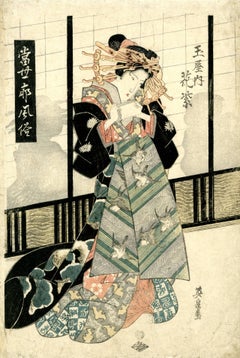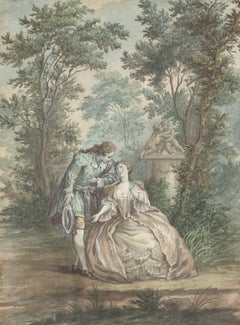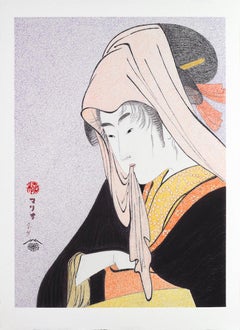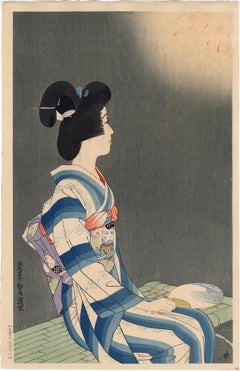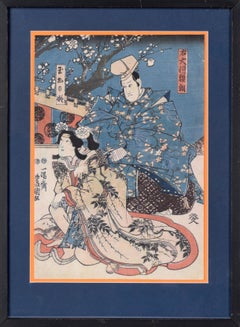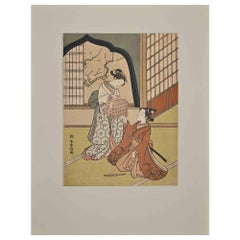Items Similar to Couple Embracing in Street at Night
Want more images or videos?
Request additional images or videos from the seller
1 of 5
Ito ShinsuiCouple Embracing in Street at Night1928
1928
$3,550
£2,696.52
€3,107.30
CA$4,999.28
A$5,542.44
CHF 2,912.77
MX$67,830.38
NOK 36,377.52
SEK 34,143.94
DKK 23,194.06
About the Item
Sumi ink drawing, c. 1928
Signed in the lower right corner (see detail)
Original illustration for the novel "Gunmo" (Hoi Polloi or Blind and Foolish Masses), volume 4 in the "Complete Works of Burafu Nakamura." Nakamura, a popular Japanese novelist and playwright, lived from 1886-1949.
Framed in acid free rag matting, OP3 Acrylic and a rounded corner metal leaf frame
Sight size: 6-3/4 x 5-3/8"
Frame size: 14-5/8 x 12-5/8 x 3/4"
Shinsui Itō (Japanese: 伊東 深水, romanized: Itō Shinsui; 4 February 1898 – 8 May 1972) was the pseudonym of a Nihonga painter and ukiyo-e woodblock print artist in Taishō- and Shōwa-period Japan. He was one of the great names of the shin-hanga art movement, which revitalized the traditional art after it began to decline with the advent of photography in the early 20th century. His real name was Itō Hajime (Japanese: 伊東 一).
Courtesy of Wikipedia
- Creator:Ito Shinsui (1898 - 1972, Japanese)
- Creation Year:1928
- Dimensions:Height: 6.75 in (17.15 cm)Width: 5.375 in (13.66 cm)
- Medium:
- Movement & Style:
- Period:
- Condition:Excellent Archival framing and presentation.
- Gallery Location:Fairlawn, OH
- Reference Number:Seller: UK10731stDibs: LU14014429942
About the Seller
5.0
Recognized Seller
These prestigious sellers are industry leaders and represent the highest echelon for item quality and design.
Platinum Seller
Premium sellers with a 4.7+ rating and 24-hour response times
Established in 1978
1stDibs seller since 2013
809 sales on 1stDibs
Typical response time: <1 hour
Associations
International Fine Print Dealers Association
- ShippingRetrieving quote...Shipping from: Fairlawn, OH
- Return Policy
Authenticity Guarantee
In the unlikely event there’s an issue with an item’s authenticity, contact us within 1 year for a full refund. DetailsMoney-Back Guarantee
If your item is not as described, is damaged in transit, or does not arrive, contact us within 7 days for a full refund. Details24-Hour Cancellation
You have a 24-hour grace period in which to reconsider your purchase, with no questions asked.Vetted Professional Sellers
Our world-class sellers must adhere to strict standards for service and quality, maintaining the integrity of our listings.Price-Match Guarantee
If you find that a seller listed the same item for a lower price elsewhere, we’ll match it.Trusted Global Delivery
Our best-in-class carrier network provides specialized shipping options worldwide, including custom delivery.More From This Seller
View AllCouple Embracing
By Ito Shinsui
Located in Fairlawn, OH
Couple Embracing
Sumi ink drawing, c. 1928
Signed lower right: Shinsui (early variant signature)
Most probably an illustration for one of the four volum...
Category
1920s Figurative Drawings and Watercolors
Materials
Ink
The Heroine Umekawa in "Meido no Kiyaku"
Located in Fairlawn, OH
Title: The Heroine Umekawa in "Meido no Kiyaku"
Medium: Color woodcut with mica background, silver metallic pigment, and "gofun" for the snow effect
Date Of Execution: 1923
Dimension...
Category
1920s Edo Figurative Prints
Materials
Woodcut
Tamaya Nishi, Hana-murasaki (Purple Flower)
By Keisai Eisen
Located in Fairlawn, OH
Signed: Keisai Eisen ga;
Seal: Kiwame
Series: Contemporary Scenes in the Pleasure Quarters
Publisher: Wakasaya Yoichi
Note: This is a famous ...
Category
Early 19th Century Figurative Prints
Materials
Woodcut
Amorous Couple
By Philibert-Louis Debucourt
Located in Fairlawn, OH
Amorous Couple
Watercolor on laid paper, c. 1810
Unsigned
Provenance: Emile Wolf (1899-1996)
The art collection of Emile Wolf was dispersed by Sotheby and Stair Galleries.
Condition: Excellent
22K gold leaf finishes corner frame (see photo)
“Mr. Wolf’s collection reflects a lifelong commitment to the arts. Although a mainstay of the Old Masters art scene in New York, Mr. Wolf’s collection spanned centuries and genres. He was an impassioned collector, and his Fifth Avenue apartment was filled with paintings and drawings that hung from floor to ceiling in every room. Space void of art was lined with an extensive library of art books that fueled his ardent collecting. Mr. Wolf took great joy in sharing this collection and his ideas with art historians, collectors, dealers and university students.
The Wolf collection included masterworks from every influential and groundbreaking Impressionist and modern artist of the late 19th and early 20th centuries, ranging from an outstanding grouping of works on paper by Picasso, Pissarro, and Cezanne to a Renoir oil...
Category
1810s Romantic Figurative Drawings and Watercolors
Materials
Watercolor
Dangerous: The Appearance of a Contemporary Geisha of the Meiji Era
By Taiso Yoshitoshi
Located in Fairlawn, OH
Dangerous: The Appearance of a Contemporary Geisha of the Meiji Era
Color woodcut, 1888
Plate 28 from the series "Thirty-two Aspects of Customs and Manners" (Fuzoku Sanjuniso)
Format...
Category
1880s Figurative Prints
Materials
Woodcut
Thirsty: The Appearance of a Town Geisha - a So-Called Wine-Server - in the Anse
By Taiso Yoshitoshi
Located in Fairlawn, OH
Thirsty: The Appearance of a Town Geisha - a So-Called Wine-Server - in the Ansei Era
Color woodcut, 1888
Signed; Seal: Taiso (see photo)
Plate 22 from the series "Thirty-two Aspects...
Category
1880s Showa Figurative Prints
Materials
Woodcut
You May Also Like
Japanese Art Figurative Painting, Love for a street-walker, Edo period
Located in Segovia, ES
LOVE FOR A STREET-WALKER
Crayon, graphite, pencil on paper.
Measurements: (H) 76 x (W) 56 cm.
Attractive portrait of an Edo prostitute hurrying through the streets. She wears a black kimono over layers of colored kimono, tucking her hand into the "obi" at her waist. A white scarf is draped over her head, the edge caught between her teeth, and loose wisps of hair framed her face. There is an impressive contrast between the black kimono and the yellow-orange of collars, sleeves and "obi", balancing the composition the pastel pink of the scarf that covers her head.
This image is part of the "bijin-ga" series, Pretty Women, drawn by Mario BGil, based in the Kitigawa Utamaro woodblock print "Love for a street-walker" (1795), 37,2 x 24,6 cm. The British Musem. London, UK.
The artist reproduces the seal of the censor (Kiwame) and from the original publisher ("Tsutaya", climbing leaf)), between the two, the signature of Mario BGil written in Japanese, with the date 14 (2014).
The mesaurements of the drawing are 76 x 56 cm. (29,92 x 22,05 in.), with a painted surface of 67 x 49,5 cm.
With his work on the "bijing-ga" series, Mario BGil wanted to embellish, give brilliance and volume to the images presented by japanese artist Kitigawa Utamaro in those beautiful engravings, ennobled with the patina of time, which have served as inspiration. The result obtained is almost life-size portraits, endowed with strong chromaticism and valuable contrasts, all enhanced, in turn, with the volume provided by the weight and rigidity of the paper, and its thick texture (Fabriano Artistico “grana grosso”, 640g/m2; the thickness and hardness of the paper makes it necessary to transport it without rolling).
In this way, Mario BGil pays tribute to his admired artist and offers us a new and enriched vision of this popular facet of oriental art from the 18th and 19th centuries.
ABOUT THE ARTIST
Mario BGil is a self-taught artist who for years has combined his creative activity with his work in the family business, away from commercial art galleries. In 2012, a deep interest in oriental art was awakened in him and he began to study the great masters of Japanese Ukiyo-e prints, who had such an influence on the European avant-garde of the late 19th century.
The discovery of Kitagawa Utamaro (1753-1806), a key figure in the metropolitan culture of Edo (now Tokyo), and a point of reference in the history of Japanese engraving...
Category
2010s Edo Figurative Drawings and Watercolors
Materials
Crayon, Paper, Pencil, Graphite
Beauty Enjoying Summer Fireworks
By Ito Shinsui
Located in Burbank, CA
Title: Fireworks 花火
Series: The Second Collection of Modern Beauties (Gendai bijin shū dai nishū 現代美人集第二輯)
Date: 1932
A young woman is shown enjoying the summer fireworks, her face shown in profile as she looks towards the display. She holds a summer fan on her lap, and her kimono features large blue stripes and is tied with a colorful obi that features a morning glory pattern. The summer evening sky is a soft grey rather than a deep black, perhaps reflecting the brightness of the fireworks. Numbered verso, from a limited edition of 250 prints.
Condition: Excellent impression, color and condition.
Publisher: Watanabe Shôzaburô
Literature: See “All the Woodblock Prints of Shinsui Ito...
Category
1920s Showa Figurative Prints
Materials
Woodcut
Two Actors - Japanese Woodblock by Chikanobu Yoshu
By Toyohara Chikanobu
Located in Soquel, CA
Two Actors - Japanese Woodblock by Toyohara Chikanobu (豊原周延, 1838–1912), better known to his contemporaries as Yōshū Chikanobu (楊洲周延).
Colorful and expressive court scene. Two actors...
Category
1890s Edo Landscape Prints
Materials
Ink, Rice Paper, Woodcut
Lovers - Woodcut after Ikkeisai Yoshichika - Mid-20th Century
Located in Roma, IT
Lovers with a Bird Cage is a woodcut print realized in the mid-20th Century after a 1789 woodcut print by Suzuki Harunobu.
Good conditions.
The artwork is depicted through soft li...
Category
1860s Figurative Prints
Materials
Woodcut
Romantic Couple In Wartime Paris on Rainy Parisian Night
Located in Miami, FL
The technique and subject matter work well together in this loosely but masterfully rendered World War 1 romantic illustration of a Soldier and a Parisian woman. Even though this wo...
Category
1930s Romantic Figurative Drawings and Watercolors
Materials
Ink, Watercolor, Pencil
Couple at Party - Drawing by Mino Maccari - 1940s
By Mino Maccari
Located in Roma, IT
Couple at Party is a Watercolor Drawing realized by Mino Maccari (1924-1989) in 1940s.
Hand-signed on the lower margin.
Good condition on a little paper.
Mino Maccari (Siena, 192...
Category
20th Century Modern Figurative Drawings and Watercolors
Materials
Watercolor
More Ways To Browse
Embrace Drawing
Antique Street Signs
Couples Drawings
Drawings Of Couples
Metal Street Signs
Embracing Couple
Antique Japanese Drawings
Antique Advent
Embracing Couples Paintings
Japanese Woodblock Couple
Shinsui Ito
Adolf Heller
Amado M Pena Jr
Andrzej Szypluk
Blackfoot Native American Dress
Henry Doane
Herbert Johnson Hat
Raymond Massey
